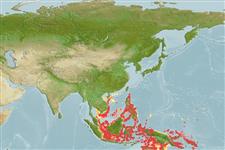>
Ovalentaria/misc (Various families in series Ovalentaria) >
Pomacentridae (Damselfishes) > Pomacentrinae
Etymology: Neoglyphidodon: Greek, para = the side of + Greek, glyphis = carved + Greek, odous = teeth.
More on authors: Fowler & Bean.
Environment: milieu / climate zone / depth range / distribution range
Ecologia
marinhas associadas(os) a recifes; não migratória; intervalo de profundidade 10 - 45 m (Ref. 7247). Tropical; 21°N - 13°S, 102°E - 163°E
Western Central Pacific: Indonesia, the Philippines, New Guinea, and the Solomon Islands.
Tamanho / Peso / Idade
Maturity: Lm ? range ? - ? cm
Max length : 13.5 cm TL macho/indeterminado; (Ref. 90102)
Descrição breve
Chaves de identificação | Morfologia | Morfometria
Espinhos dorsais (total) : 13; Raios dorsais moles (total) : 12 - 14; Espinhos anais: 2; Raios anais moles: 13 - 14.
Adults inhabit coral-rich areas of outer reef slopes (Ref. 9710). They occur in small groups. Juveniles stay close to substrate but adults may swim high above to feed on zooplankton (Ref. 48636). Oviparous, distinct pairing during breeding (Ref. 205). Eggs are demersal and adhere to the substrate (Ref. 205). Males guard and aerate the eggs (Ref. 205). Diurnal species (Ref. 113699).
Life cycle and mating behavior
Maturidade | Reprodução | Desova | Ovos | Fecundidade | Larvas
Oviparous, distinct pairing during breeding (Ref. 205). Eggs are demersal and adhere to the substrate (Ref. 205). Males guard and aerate the eggs (Ref. 205).
Allen, G.R., 1991. Damselfishes of the world. Mergus Publishers, Melle, Germany. 271 p. (Ref. 7247)
Categoria na Lista Vermelha da IUCN (Ref. 130435: Version 2024-1)
Ameaça para o homem
Harmless
Utilização humana
Ferramentas
Relatórios especiais
Descarregue XML
Fontes da internet
Estimates based on models
Preferred temperature (Ref.
123201): 27.1 - 29, mean 28.2 °C (based on 210 cells).
Phylogenetic diversity index (Ref.
82804): PD
50 = 0.5020 [Uniqueness, from 0.5 = low to 2.0 = high].
Bayesian length-weight: a=0.02344 (0.01134 - 0.04848), b=2.98 (2.80 - 3.16), in cm total length, based on LWR estimates for this (Sub)family-body shape (Ref.
93245).
Nível Trófico (Ref.
69278): 2.7 ±0.29 se; based on food items.
Resiliência (Ref.
120179): Elevada, tempo mínimo de duplicação da população menor que 15 meses (Preliminary K or Fecundity.).
Fishing Vulnerability (Ref.
59153): Low vulnerability (10 of 100).
Nutrients (Ref.
124155): Calcium = 93.8 [47.8, 144.6] mg/100g; Iron = 0.711 [0.441, 1.150] mg/100g; Protein = 18.2 [17.0, 19.3] %; Omega3 = 0.115 [0.072, 0.182] g/100g; Selenium = 27.3 [15.5, 49.6] μg/100g; VitaminA = 80.6 [22.1, 272.8] μg/100g; Zinc = 1.63 [1.13, 2.34] mg/100g (wet weight);
